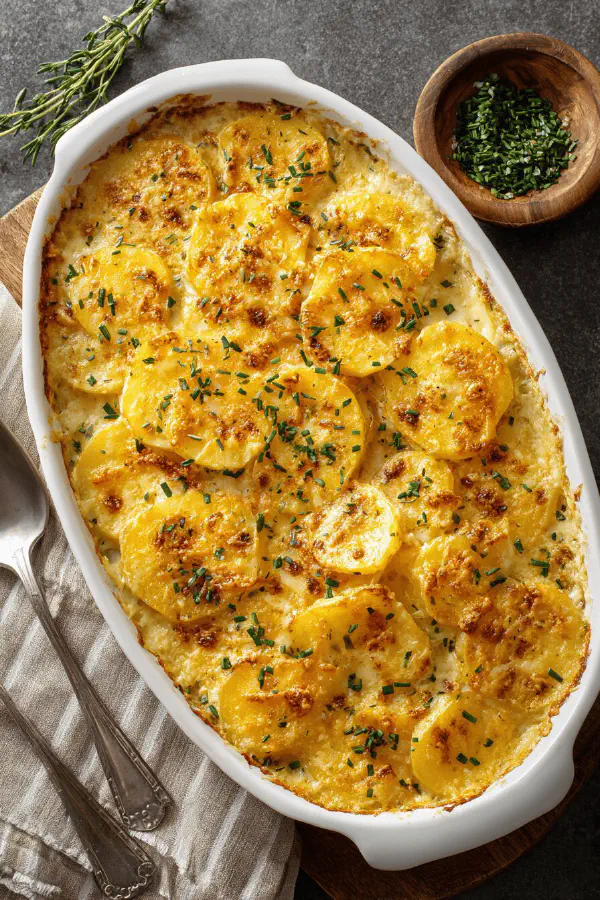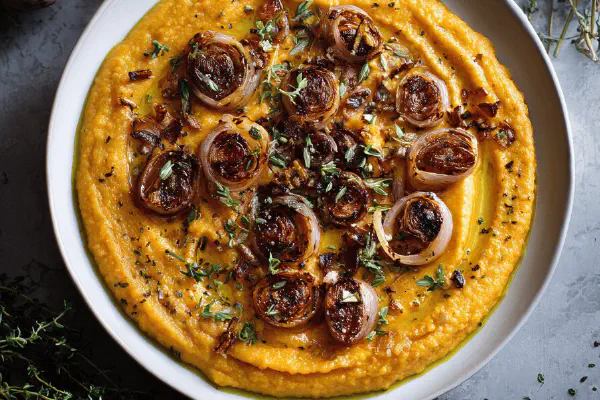Featured Recipe
Creamy Potato Gratin

By Kate
"
Slow-baked layered potato dish with Swiss cheese and cream. Thin slices keep texture tender but intact. Cheese swapped for Gruyère for nuttier bite. Garlic-infused cream adds depth. No rinsing starch keeps sauce glossy and thick. Baked covered then uncovered to brown edges and top. Rest before cutting to firm layers. Classic French technique, practical with tweaks for better flavor and function. Can substitute potatoes or cheese, adjust bake time by visual signs. Serves 6 hearty portions, rich yet balanced.
"
Prep:
25 min
Cook:
Total:
Serves:
6 servings
French cuisine
comfort food
baked dishes
potato recipes
Introduction
Potato gratin isn’t about rush. Layers build slowly, flavours deepen. Texture comes from unwashed starch sticking around. Gruyère swaps Emmental bringing deeper, nuttier notes without overpowering. Garlic infused cream — not minced into dish but rubbed on baking dish — allows gentle perfume through steaming. Oven temp moderate, enough for slow melting and softening, then finish uncovered to toast the top. Time? A rough guide. Watch edges crackle, listen for bubbling sauce, feel the softened potato slices with gentle poke through foil before pulling cover. Letting it rest, that’s where it all gels: the final play before cutting. For a side, main, whatever. Keep salt balanced — you can always add at table but taking cheese saltiness into account up front stops oversalting. Simple ingredients, mastered technique. No shortcuts.
Ingredients
About the ingredients
Potatoes matter here. Yukon Gold hold shape well yet yield creamy texture when thinly sliced. Russets or other starchy types might break down too much, waxy tend to stay firmer but less creamy. Not rinsing the slices means starch surrounds each piece, thickening sauce naturally. Cheese: Gruyère adds nutty depth, melts well with great flavor. Substitute with Emmental or a mild cheddar for different profiles. Cream ideally heavy, around 35-38 percent fat, ensuring rich sauce that doesn’t separate. Garlic crushed and rubbed on dish adds aroma without harsh bite. Butter for greasing prevents sticking and adds browning on edges. Salt and pepper finish carefully — cheese and cream add salt, so start conservative.
Method
Technique Tips
Slicing potatoes thin and uniform is crucial; uneven slices cook unevenly, risk mushy or underdone spots. Mandoline best tool but keep fingers safe with guard. Not rinsing after slicing is a conscious choice to preserve starch, helping bind sauce. Buttering dish plus garlic rubbing enhances flavor and prevents sticking on crisp edges. Alternate layering potatoes, cheese, and cream to ensure even cooking and distribution. Covering with foil traps moisture, prevents drying out during long bake. Baking time depends on oven; look for potatoes softened through, cream bubbling on edges. Remove foil to brown top and get crisp edges, visual cue of doneness. Resting completes cooking by allowing sauce to thicken, layers to set. When cutting, knife should pass cleanly without collapsing gratin. If sauce runs or potato is very loose, slice slower or longer rest next time. Cheese substituted must melt well or texture suffers. Keep an eye on oven temp consistency. If browning too fast, lower temp and extend bake. A layering dish can be prepped ahead; cover and refrigerate, increase cooking time slightly. Keep warm covered before serving to avoid crust drying.
Chef's Notes
- 💡 Use a mandoline for even slices, key for consistent cooking. 2 mm is ideal. Uneven thickness, different doneness. Don't wash slices. Starch keeps it creamy.
- 💡 Butter the dish before layering. Add crushed garlic, rub it well. Aroma is subtle but present. Builds flavor profile from inside out. Crisp edges mean better texture.
- 💡 Layering potatoes tightly creates structure. Cheese and cream in-between ensure goodness. Remember, don’t skimp. Finish with cream on top. Layering alternates brings even cooking.
- 💡 Cover with foil. Steam helps soften potatoes. After an hour, peek—bubbling edges mean it’s working. Remove foil for browning. Consistent heat is crucial to prevent burning.
- 💡 Rest before cutting. At least 10 minutes minimum. Helps firm up layers, aids slicing. If you rush this part, it falls apart. Take the time, see the difference.
Kitchen Wisdom
What's a common mistake?
Not checking doneness. Ovens vary. Check for bubbling cream, fork test on potatoes. If undercooked, return to oven covered.
Can I prep ahead?
Absolutely. Assemble and refrigerate. Increase bake time if cold. Watch for visual cues and smells. Keep an eye on it.
What if it’s too watery?
Make sure starch stays. If using low-fat cream, it can separate. Also, rest the dish, helps sauce thicken.
How should I store leftovers?
Refrigerate in airtight. Reheat slowly in oven for best texture. Avoid microwave for crispy edges. Can also freeze, but texture changes.



